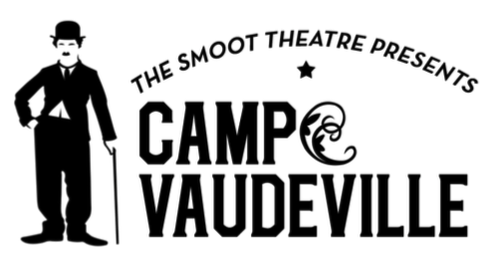CAMP VAUDEVILLE AUDITION SPEECHES & Songs
Do you have a special skill or talent that could be featured in this year's show?
Come to auditions and show us what ya' got! Here are some ideas:
Come to auditions and show us what ya' got! Here are some ideas:
|
|
LIST OF PERFORMERS IN 2024 CAMP VAUDEVILLE
HUCKSTER GIRL (singing) – WHERE DID YOU GET THAT HAT?
LOTTA CRABTREE (speaking and singing) – OH, THEM GOLDEN SLIPPERS
HARRIGAN & HART (speaking and singing) – MULLIGAN GUARD’S MARCH
CARNEY (singing) – LYDIA, THE TATTOOED LADY
HILTON SISTERS (speaking and singing) – SIDE BY SIDE
BUFFALO BILL CODY (speaking)
ANNIE OAKLY (speaking)
GILDA GRAY (speaking and singing) – I WISH I COULD SHIMMY LIKE MY SISTER KATE
RUTH ETTING (speaking and singing) – KEEP YOUNG AND BEAUTIFUL
These are just some of the speaking parts in our Camp Vaudeville this year. If you audition, you may not necessarily
be cast in the role for which you auditioned. You could be assigned another speaking part in the show.
Huckster Girl - Where Did You Get That Hat?
|
|
Where did you get that hat,
Where did you get that tile? Isn't it a nobby one and Just the proper style? I should like to have one, Just the same as that. Where'er I go they shout "'Hello!" Where did you get that hat? |
Lotta Crabtree - Oh, Them Golden Slippers
|
|
I was born in New York City, but when the California Gold Rush started my father moved our family West. We finally settled in the boomtown of Rabbit Creek where my mother started running a boarding house.
I saw the dancer Lola Montez perform and knew that was what I was going to do with my life. So, I got a couple of musicians together and set out in a covered wagon with my name painted on it and started singing and dancing and playing the banjo, touring the California mining camps and making a name for myself. I became known as “The Golden Girl”. The family eventually made it to San Francisco where I became a headliner at the Gaieties Temple of Mirth and Song Theatre and Saloon. They called me “San Francisco’s Favorite”. |
Harrigan & Hart - Mulligan Guard's March
|
|
HARRIGAN: I’m Ned Harrigan and I started out as a comedian in variety halls in San Francisco.
HART: And I’m Tony Hart. I was a stage-struck kid out of reform school with a great gift for comedy. HARRIGAN: We met in the mid 1870’s and developed a routine that poked fun at New York’s neighborhood militias. HART: These local “guard” units were little more than drinking clubs with tipsy weekend parades. HARRIGAN: The catchy song we wrote and sang in our act was soon being sung all around the world. HART: So, we turned it into a series of shows with dialogue about the immigrants in the lower and middle class and they became a sensation in New York. |
Carney - Lydia the Tattooed Lady
|
|
Hilton Sisters - Side by Side
|
|
VIOLET: Hello, my name is Violet Hilton.
DAISY: And I am Daisy Hilton. VIOLET: We were born conjoined twins. DAISY: What that means is that we joined together at our hips – a very rare condition. VIOLET: At a very early age we started performing in sideshows and later went into vaudeville. DAISY: At one time we were in an act with Bob Hope doing a tap-dancing routine. VIOLET: We even played right here on the Smoot stage. DAISY: You can see our picture upstairs in the showcase. VIOLET: We are going to sing a song for you now, which I know you are going to love. DAISY: I’d say it’s the perfect song for us! |
Buffalo Bill Cody
|
|
I was the most famous figure of the American Old West. I was already a legend by the age of 23. At age 14 I caught “gold fever” and decided to head to California from my home in Iowa to make my fortune. Along the way I met an agent for the Pony Express and became a rider, delivering the mail for them. I joined the Union Army in the Civil War at age 17 and afterward joined my friend Wild Bill Hickok as a scout for the Army and later for the railroad. I began to hunt buffalo for them in order to supply meat for the workers and was so successful I got my nickname of Buffalo Bill. A writer for the newspaper started writing a series of articles about my adventures, which were published on the front page of the Chicago Tribune, and I became known all over America. That’s when I started Buffalo Bill’s Wild West Show
|


